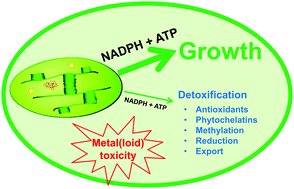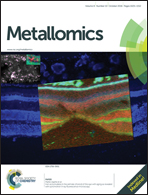Energy cost of intracellular metal and metalloid detoxification in wild-type eukaryotic phytoplankton†
Abstract
Microalgae use various cellular mechanisms to detoxify both non-essential and excess essential metals or metalloids. There exists however, a threshold in intracellular metal(loid) concentrations beyond which detoxification mechanisms are no longer effective and inhibition of cell division inevitably occurs. It is therefore important to determine whether the availability of energy in the cell could constrain metal(loid) detoxification capacity and to better define the thresholds beyond which a metal(loid) becomes toxic. To do this we performed the first extensive bioenergetics analysis of intracellular metal(loid) detoxification mechanisms (e.g., metal-binding peptides, polyphosphate granules, metal efflux, metal and metalloid reduction, metalloid methylation, enzymatic and non-enzymatic antioxidants) in wild-type eukaryotic phytoplankton based on the biochemical mechanisms of each detoxification strategy and on experimental measurements of detoxifying biomolecules in the literature. The results show that at the onset of metal(loid) toxicity to growth, all the detoxification strategies considered required only a small fraction of the total cellular energy available for growth indicating that intracellular detoxification ability in wild-type eukaryotic phytoplankton species is not constrained by the availability of cellular energy. The present study brings new insights into metal(loid) toxicity mechanisms and detoxification strategies in wild-type eukaryotic phytoplankton.

- This article is part of the themed collection: Metals in marine biochemistry


 Please wait while we load your content...
Please wait while we load your content...